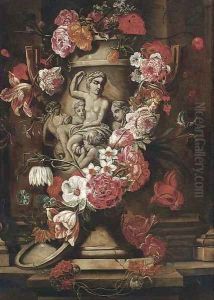Caspar Pieter II Verbrugghen Paintings
Caspar Pieter II Verbrugghen was a Flemish sculptor and woodcarver known for his Baroque style works during the late 17th and early 18th centuries. He was born in 1664 in Antwerp, a city that was then part of the Spanish Netherlands and is now in Belgium. Caspar belonged to the Verbrugghen family, which included several notable artists of the time. His father, Pieter Verbrugghen I, was also a respected sculptor, and it is likely that Caspar Pieter II learned the craft under his tutelage.
During his career, Verbrugghen produced works primarily for religious contexts, such as altarpieces, pulpits, and statues for churches. His style was characterized by dynamic movement, dramatic expressions, and intricate detailing, which are hallmarks of the Baroque sensibility. The Baroque period was known for its emphasis on emotion, grandeur, and richness in art, and Verbrugghen's works were no exception.
One of Verbrugghen's notable contributions is his work in the St. James' Church (Sint-Jacobskerk) in Antwerp, where his craftsmanship can be seen in the elaborate confessionals and other decorative elements. These works exemplify his ability to transform wood into seemingly fluid and lifelike forms, a testament to his mastery of the material.
Verbrugghen's influence extended through his teaching as well, as he instructed the next generation of artists in the art of sculpting. His legacy continued through his descendants, who also became artists. Caspar Pieter II Verbrugghen died in 1730, leaving behind a body of work that continued to inspire and influence Baroque art in the region. His contributions are still admired today for their technical skill and artistic beauty.
